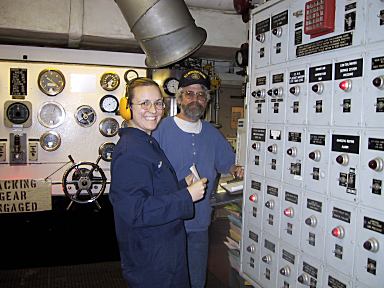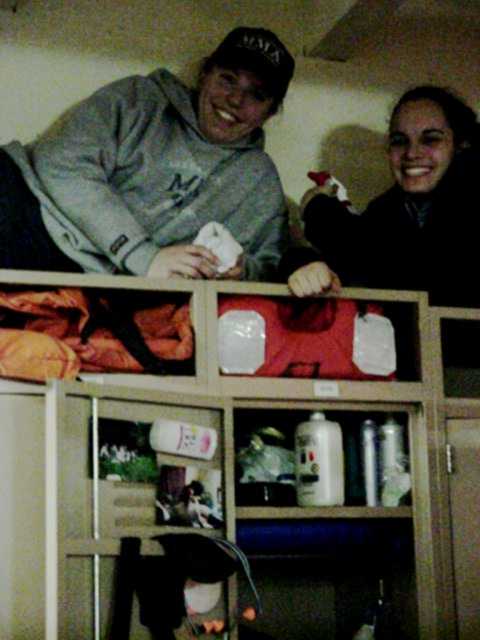
| January 2001 | ||||||
| Sun | Mon | Tue | Wed | Thu | Fri | Sat |
| 1 | 2 | 3 | 4 | 5 | 6 | |
| 7 | 8 | 9 | 10 | 11 | 12 | 13 |
| 14 | 15 | 16 | 17 | 18 | 19 | 20 |
| 21 | 22 | 23 | 24 | 25 | 26 | 27 |
| 28 | 29 | 30 | 31 | |||
At 0700 EST the T/S Empire State was enroute to Willemstad, Curacao and located at 27 degrees and 38 minutes North Latitude and 73 degrees 36 minutes West Longitude. (Approximately 250 east of Cape Canaveral) She was steering course 197 degrees true at a speed of 16 knots. The skies were cloudy with winds out of the southeast at 05 knots. Barometric pressure was 1020 millibars of mercury. The air temperature was 70 degrees and seawater was 71 degrees. Seas were 2 to 4 feet. Depth of water beneath the keel was 2800 fathoms.

It may be getting warm outside, but it is always hot in the engine room.

CAPTAIN'S LOG:
The first day of training is behind us and everything flattens out from here. We have located all the errant people (staff members included). The ladder to nowhere eventually leads to the galley and we go there first to locate those temporarily caught in the infamous port-starboard time warp. Smells from the bakery help them find the yellow brick road to civilization and the flavorful bread often holds them until help arrives.
The first day of training also marks the long dreaded first official inspections of the berthing compartments. The lights come on early down there from now on, and are not extinguished until the space sparkles. That fact is particularly irksome to the midwatch. But, cleanliness is next to godliness and since the reward for efficiency is the opportunity to sleep, that task is quickly and professionally accomplished.

Then, last evening, we experienced some realistic training in the form of a fire alarm. The signal called the fire parties to action and everyone responded as if they had experience with the Boston Fire Department. Teams quickly donned protective equipment and set crucial fire boundries. Hoses were prepared and inspections were meticulously completed but no sign of fire could be found. We were about to conclude that the alarm had malfunctioned when someone followed his nose to an officer's stateroom. There he discovered an aromatic pipe and long blue trails of smoke reaching up to kiss the very sensitive smoke detector. Smoke detector tested; test satisfactory.
Shortly thereafter, and after everyone had returned to sleep, a hapless 4/C cadet managed to ensnare the ship's whistle lever in his flashlight strap. The action locked the whistle in the "ON" position. As one would expect, no amount of fumbling with it secured the noise until everyone asleep above the main deck was wide awake. Don't you know... That is why we call this Sea Term for training. See You Tomorrow from the Bahamas.
Cadet 3/C Erin Lawrence, Daily Thoughts
Hello warm weather, blue skies, and calm seas!! As the divisions split up into maintenance, watch, and training, division three drew maintenance. Our job for the day was to mop all outside decks. With soot continuosly raining down from the stack above, that was a difficult task. No one complained though, and that's because the warm rays from the sun kept our morale high. Cadets are continuosly soaking up the rays, lying outside in their free time, myself included. When cadets have a free minute they head outside into the warm, salty air. The gentle roll of the ship mixed with the sunshine, are the necessary ingredients for a nice nap. The things that I enjoy most about cruise are the night sky and the stars. You see more stars than one can even imagine. The sky seems to be filled with hundreds of fireflies. The beautiful evening sky is the perfect ending to a wonderful day at sea. Smooth sailing from here on in!
QUESTIONS FOR WEDNESDAY 17 JANUARY 2001
MATH:
Parallels of Latitude begin at the Equator. Given the earth is approximately 8000 miles in diameter, compute the length of the equator.
SCIENCE:
Name the three basic ways that heat energy from the sun is spread throughout the atmosphere.
GEOGRAPHY: Name the major shipping route that separates the Islands of Cuba and Hispaniola.
HISTORY:
What famous explored is credited with discovering many of the Islands in the Caribbean.
ANSWERS FOR TUESDAY 16 JANUARY 2001
MATH: 6080/5280 = 1.151 Then 1.151 X 12.5 knots = 14.4 miles per hour.
SCIENCE: Wind speed is measured with an ANEMOMETER.
Atmospheric pressure is measured with a BAROMETER.
Relative Humidity is measured using a PSYCHROMETER.
OOPS! There were only three, not four.
Congratulations to the Sea Wind Team at Bourne Middle School for catching us.
GEOGRAPHY:
The Gulf Stream begins at the Straits of Florida and ends at the Grand Banks in the North Atlantic.
HISTORY:
Mr. Benjamin Franklin is credited with mapping the Gulf Stream.